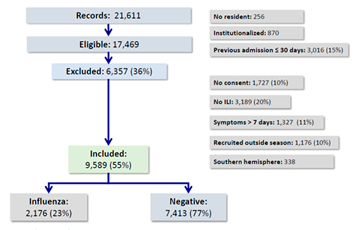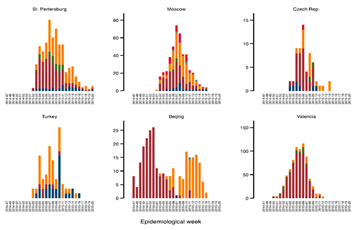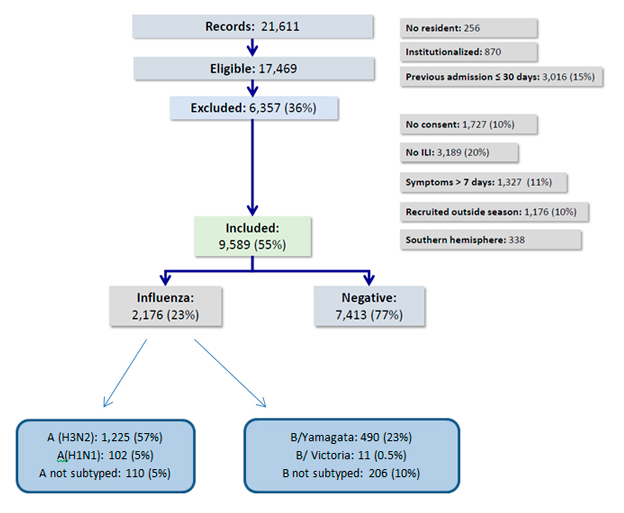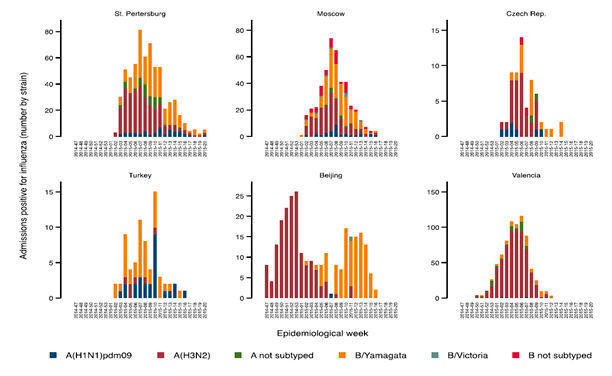40 participants from 14 countries including flu experts and health representatives from the US-CDC, ECDC and the WHO attended the meeting.
Summary of the 2014-2015 season results
In 2014-2015, the GIHSN included 27 hospitals across 6 countries (Russian Federation, Czech Republic, Turkey, China, Brazil and Spain) in the Northern Hemisphere. It was a pilot year for Czech Republic.
The pooled analysis, however, included only 24 hospitals in 5 countries since Brazil (3 hospitals) kept enrolling patients until end of September in Curitiba, and Fortaleza will stop recruiting in December 2015.
Inpatients were enrolled from November 2014 to May 2015 in the Northern hemisphere.
The highest wave of hospital admissions started during weeks 3-4, slowly declined after week 11, with a peak of number of admissions around weeks 7 and 8, 2015.
Eligible inpatients were >6mo in 23 study sites, or >18yo in one study site.
Although distribution varied amongst sites, inside sites and over time, predominant viruses were influenza A(H3N2) (57%) and influenza B/Yamagata (23%), with a smaller proportion of A(H1N1) and B/Victoria.
A(H3N2) viruses were genetically different from the strain in the vaccine.
In comparison with previous season, an increase of influenza B activity was noticed.
Influenza type B was predominant in Turkey and Moscow whereas influenza A(H3N2) was predominant in China.
Burden of disease
All age groups were affected, although 0-4 year-old children were the most affected in Saint Petersburg, Moscow, Turkey and Beijing. In Valencia, there was a high prevalence of influenza cases also amongst >65yo. Therefore, the burden of disease especially increased in children and elderly.
Pregnancy and obesity were confirmed as significant risk factors for hospitalization due to influenza. Pregnancy is an outstanding risk factor for ILI admission: pregnant vs non pregnant OR = 2,8 (CI 1.9 – 4.2). Comorbidity combined with pregnancy increased this risk even more (OR= approximately 7).
More generally, comorbidity increased the risk of influenza and this was the case for all influenza strains.
Vaccine effectiveness
Preliminary estimates of Influenza Vaccine Effectiveness (IVE) for the GIHSN 2014/15 season were presented at the meeting. Despite the vaccine mismatch, being vaccinated reduced the risk of being admitted to a hospital with influenza by 26%, after adjustment by network.
Other significant results against each of the predominant strains are as follows:
- 21% IVE against H3N2 for all ages
- 49% IVE against B/Yamagata for all ages
- An increased IVE in elderly (IVE 2% vs 28% in <65yo vs >65 yo)
Challenges
Provide interim robust estimates by increasing frequency of data collection and cleaning.
Keep focused on applying a consistent across-season core protocol in order to be able to pool and compare across seasons.
Other
Created in September 2015, the Foundation for the Influenza Epidemiology was officially launched during the Global Annual Meeting.






Comments are closed.